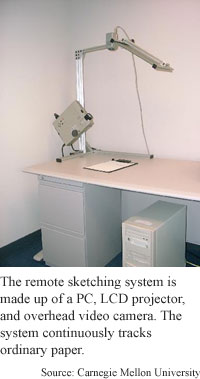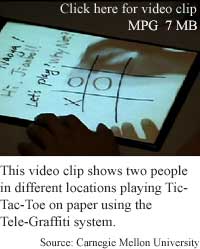
Pen
and paper networked
By
Chhavi Sachdev,
Technology Research NewsPeople who do hands-on graphics work and travel a lot will appreciate this. Researchers at Carnegie Mellon University have a built a communication system that allows two or more users to communicate remotely via hand-drawn sketches. With it, an architect in Paris and her colleague in Singapore can sketch out a floor plan together, in real time, using pen and paper.
The system, dubbed Tele-Graffiti, consists of a pair of liquid crystal display (LCD) projectors and video cameras connected over a network. The cameras capture a person’s pen marks as they are made on an ordinary piece of paper in its view. The video is transmitted to the projector on the other side of the connection, which then beams the image onto the collaborator’s paper.
The system allows two people to “interact as though they are both writing on the same piece of paper, whereas in reality they could be thousands of miles away,” said Simon Baker, a Research Scientist at the Robotics Institute of Carnegie Mellon.
When the system is turned off, the users only see the marks they drew on their own papers, but during communications both inputs appear simultaneously.
“The key thing is that each person can write on a regular piece of paper with a regular pen on their own desk. They can also place the paper anywhere they like on the desk and move it around as they want to,” said Baker. This means that a notepad with the sketch can be passed around a table without it losing orientation, allowing several people to write on it at each side of the connection.
The trick to being able to play tic-tac-toe on real paper with someone in the next room or in Bahrain is precision. The cameras track the edges of the paper so that pen marks from the two sources maintain the same relative position.
“Because the position of the paper is also known [on the other side], the computer can work out how to project what it has read so that it appears at exactly the right position. In this way, the two people effectively share the same piece of paper,” he said.
Over a 100 megabits-per-second Local Area Network (LAN), the system can transmit about 15 frames per second. The time lag is about a quarter of a second. While this may be a considerable delay for a telephone conversation, it doesn’t matter for sketching and writing because this communication is, by nature, slower, Baker said.
Were the users to connect via the Internet rather than over a LAN, the system would slow down. “The transmission is like streaming video over the internet. If you have a faster link, the video can be better quality [and] Tele-Graffiti does require a fairly high bandwidth connection,” he said. “Over a direct internet connection, we would get [about] 2-3 frames per second.”
Two areas in which the researchers envision using Tele-Graffiti are in remote education and remote design.
Many universities conduct remote classes for corporate clients and sketches can be a big component, Baker pointed out. A teacher could see if students understood a design and correct them if they didn’t.
Similarly, architects or interior designers in different cities could “teleconference and also draw ideas of designs that they can both see and both add to,” he said. Another application could be to fill out Web forms using a pen, without having to download, print, or scan any information.
While other research groups have coupled a video camera and LCD projectors, those efforts have focused on human-computer interaction. “Our work is different in that it is a dedicated remote communication system,” said Baker.
While there is, indeed, a history of video-based document sharing and marking, “this looks like a very cool system and idea,” said Saul Greenberg, a professor of Computer Science at the University of Calgary in Canada.
“The nice thing about having the image on the pad is that local people can pass it around to each other [and] it will follow them. Of course, we could do this with a laptop/tablet PC, but having it recognize just video means that non-computer people can use it, and they can bring everyday things into it,” Greenberg said.
The researchers are working on adding audio signals and face-tracking to make a remote-sketching teleconferencing system, said Baker. They are also looking to archive sessions, he said. “That way the design process can be re-played efficiently so that the architects can reconstruct how they came up with the final design and the options they considered and discarded on the way.”
Currently, the system does not compress or reduce the video stream very much before transmitting it. More sophisticated compression would allow for faster transmission speeds over networks like the Internet. The system could be used in commercial applications in less than 2 years, according to Baker.
Baker’s research colleagues were Naoya Takao, Jianbo Shi, Iain Matthews, and Bart Nabbe. They published the research in the Proceedings of the 8th IEEE International Conference on Computer Vision held in Vancouver, British Columbia in July, 2001. The research was funded by Carnegie Mellon University.
Timeline: > 2 years
Funding: University
TRN Categories: Computer Vision and Image Processing
Story Type: News
Related Elements: Technical paper, "Tele-Graffiti: A Paper-Based Remote Sketching System," presented at the 8th IEEE International Conference on Computer Vision held in Vancouver, British Columbia, July 2001.
http://metal.ius.cs.cmu.edu/tg/index.shtml#movie
Advertisements:
September 5, 2001
Page One
Pen and paper networked
Quantum current closer to computing
Correction choices key for speech software
Software spins tales into animations
Watched quantum pot boils slower


News:
Research News Roundup
Research Watch blog
Features:
View from the High Ground Q&A
How It Works
RSS Feeds:
News
Ad links:
Buy an ad link
| Advertisements:
|
 |
Ad links: Clear History
Buy an ad link
|
TRN
Newswire and Headline Feeds for Web sites
|
© Copyright Technology Research News, LLC 2000-2006. All rights reserved.